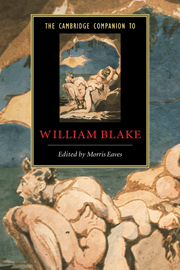Book contents
- Frontmatter
- 1 Introduction
- Part I Perspectives
- Part II Blake's works
- 10 Blake's early works
- 11 From America to The Four Zoas
- 12 Milton and its contexts
- 13 Jerusalem and Blake's final works
- A glossary of terms, names and concepts in Blake
- Guide to further reading
- Seeing Blake's art in person
- Index
- Series List
11 - From America to The Four Zoas
from Part II - Blake's works
Published online by Cambridge University Press: 28 May 2006
- Frontmatter
- 1 Introduction
- Part I Perspectives
- Part II Blake's works
- 10 Blake's early works
- 11 From America to The Four Zoas
- 12 Milton and its contexts
- 13 Jerusalem and Blake's final works
- A glossary of terms, names and concepts in Blake
- Guide to further reading
- Seeing Blake's art in person
- Index
- Series List
Summary
Like some other radicals in the 1790s, Blake saw the American revolution as igniting a process of liberation that would sweep around the globe, exploding repressive superstitions and causing despotic governments to crumble. Some envisaged this process as a fulfillment of the enlightenment that would establish universally acceptable principles of justice based on reason rather than on corrupt tradition. But Blake's antinomianism led him to see the enlightenment as an extension of the errors it aimed to dispel. He imagined global revolution not as universalizing the rule of reason, but as liberating desire and spreading “thought-creating fires” (SL 6:6, E 68).
The vision was certainly rebellious, but Blake himself cut an odd figure as a revolutionary. The links between his prophetic art and contemporary radicalism have been widely explored, but identifying a contemporary fit audience has proved difficult. When he composed America (1793), the first of his “continental prophecies,” he may have thought of it as an intervention in the political debate stimulated by the French revolution. But the advertised price of 10s. 6d. (E 693) put it well out of reach of a popular audience. It was his most ambitious illuminated book to date, with plates more than four times bigger than the Innocence plates.
- Type
- Chapter
- Information
- The Cambridge Companion to William Blake , pp. 210 - 230Publisher: Cambridge University PressPrint publication year: 2003
- 3
- Cited by



